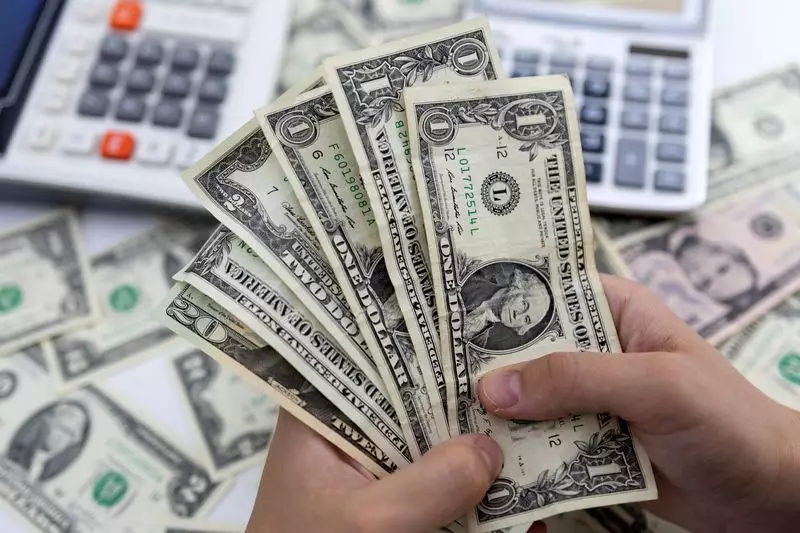In the evolving landscape of global finance, currency values often react sharply to political decisions and economic forecasts. Recently, the U.S. dollar has been under pressure, hitting a fresh two-week low in response to the ambiguity surrounding President Donald Trump’s trade policies. As discussions about tariffs loom large, investors are left grappling with uncertainty, putting the greenback on shaky ground against its major rivals. This article delves into the recent developments affecting the dollar and explores the broader implications for the global currency markets.
On the surface, the dollar’s recent decline can be traced back to President Trump’s announcements regarding potential tariffs. Trump signaled discussions surrounding a proposed 10% tariff on Chinese imports, a stark reminder of the trade tensions that characterized his administration. In addition, he hinted at possible tariffs on imports from Mexico and Canada, as well as Europe. However, the lack of concrete details has exacerbated market uncertainty. This week alone, the dollar experienced a 1.2% drop against a basket of major currencies, indicating a significant reaction to the uncertain trade environment.
Market analysts suggest that Trump’s vague indications of new tariffs underline a tenuous economic strategy. Investors have been left guessing about the administration’s commitment to aggressive trade protectionism. The dollar index, which measures the currency’s performance against six major global currencies, dipped to its lowest levels since early January, raising alarms about the currency’s stability in the coming weeks.
Despite the initial slide, there have been fluctuations in the dollar’s performance as traders attempt to navigate the unpredictable terrain. For instance, while the dollar briefly stabilized on Tuesday, this uptick proved short-lived, highlighting the market’s inability to find firm footing amid political uncertainty. The dollar’s activity against the Japanese yen illustrates this trend, with the currency peaking at 156 yen, although it subsequently struggled to maintain this strength.
As the euro fluctuated within trading sessions, it eventually reversed a 0.3% decline to rise to levels not seen since late December. The British pound also exhibited resilience, temporarily reaching a two-week high against the dollar before capitulating slightly. These movements have led analysts to speculate that upcoming Federal Reserve interest rate cuts could further complicate the dollar’s outlook, as traders anticipate a quarter-point reduction by mid-year.
Economic commentators have mulled over Trump’s proposed economic policies, suggesting that while they may spur growth, inflation risks remain a considerable concern. The cautious nature of the proposed tariff strategies has raised expectations that inflationary pressures may not escalate as previously feared. As inflation remains a critical indicator for market stability, the current tariff discourse plays a fundamental role in shaping financial forecasts.
Expectations for the Federal Reserve’s interest rate moves are increasingly burdened by these developments, with markets anticipating a cautious approach from the Fed amid evolving inflationary conditions. The Canadian dollar’s relative weakness against the U.S. dollar and the slight upswing of the Mexican peso are further reflections of how interconnected these currency dynamics are, signaling a potential tightening of monetary policy across North America.
Strategic Trade Negotiations: A New Approach?
Interestingly, some analysts are interpreting Trump’s actions as a potential pivot away from extreme trade protectionism. The proposed 10% tariff on China is considerably less aggressive than the 60% rate he previously championed during his campaign. This shift suggests that rather than pursuing uncompromising trade barriers, the administration may be positioning itself for strategic negotiations that could yield favorable outcomes over time.
As the global trade environment continues to shift, the dollar’s recovery may hinge on the administration’s ability to balance its protective measures with the necessary diplomatic engagement. The overarching sentiment seems to echo that while immediate fears of rampant tariffs may subside, the intricacies of trade negotiations will play a prominent role in the dollar’s trajectory moving forward.
The current trajectory of the dollar is emblematic of the broader uncertainties facing global markets. As discussions around tariffs evolve, market players must remain vigilant and adapt to shifts in financial sentiment. With inflation forecasts, potential interest rate cuts, and ongoing trade negotiations in play, the coming weeks will be critical for determining the dollar’s standing on the international stage. Ultimately, a careful balancing act between growth and inflation will dictate the greenback’s longevity amidst a highly volatile economic climate.

